
Andy Lloyd's Dark Star Blog

Blog 27 (June 2015)
The 'Oort Star' Pops Up Again
A recent article on The Daily Galaxy provided readers
with further details about the star (Scholz's Star) which probably
passed through the outer regions of the solar system just 70,000 years
ago (1). The story prompted the usual grumbles about how the
doom-mongering conspiracy theorists would quickly identify such an event
with Nibiru, or Nemesis, etc. Hey... live with it!
Conspiracy theorists sometimes get it right, after all.
It's certainly possible that such an event might have
caused a perturbation of the Oort Cloud, sending comets down towards the
Sun from the previously stable orbits, although astronomers are not
convinced that this would have been as dramatic as one might imagine
(the outer Oort Cloud being extremely diffuse at this distance).
It's also of great interest to note that this event happened during the
near Pleistocene, commensurate with the presence of modern humans on our
planet. Perhaps Scholz's star was close enough to be a significant
stellar spectacle in the sky. "Astronomers have identified
the closest known flyby of a star to our solar system: A dim star that
passed through the Oort Cloud 70,000 years ago. A group of astronomers
from the US, Europe, Chile and South Africa have determined that 70,000
years ago a dim star is likely to have passed through the solar system's
distant cloud of comets, the Oort Cloud (image above). No other star is
known to have ever approached our solar system this close - five times
closer than the current closest star, Proxima Centauri. "The star's trajectory
suggests that 70,000 years ago it passed roughly 52,000 astronomical
units away (or about 0.8 light years, which equals 8 trillion kilometers,
or 5 trillion miles). This is astronomically close; our closest neighbor
star Proxima Centauri is 4.2 light years distant. In fact, the
astronomers explain in the paper that they are 98% certain that it went
through what is known as the "outer Oort Cloud" - a region at the edge
of the solar system filled with trillions of comets a mile or more
across that are thought to give rise to long-term comets orbiting the
Sun after their orbits are perturbed. "While the close flyby of
Scholz's star likely had little impact on the Oort Cloud, Mamajek points
out that "other dynamically important Oort Cloud perturbers may be
lurking among nearby stars." The recently launched European Space Agency
Gaia satellite is expected to map out the distances and measure the
velocities of a billion stars. With the Gaia data, astronomers will be
able to tell which other stars may have had a close encounter with us in
the past or will in the distant future. "Currently, Scholz's star is
a small, dim red dwarf in the constellation of Monoceros, about 20 light
years away. However, at the closest point in its flyby of the solar
system, Scholz's star would have been a 10th magnitude star - about 50
times fainter than can normally be seen with the naked eye at night. It
is magnetically active, however, which can cause stars to "flare" and
briefly become thousands of times brighter. So it is possible that
Scholz's star may have been visible to the naked eye by our ancestors
70,000 years ago for minutes or hours at a time during rare flaring
events. The star is part of a binary star system: a low-mass red dwarf
star (with mass about 8% that of the Sun) and a "brown dwarf" companion
(with mass about 6% that of the Sun). Brown dwarfs are considered
"failed stars;" their masses are too low to fuse hydrogen in their cores
like a "star," but they are still much more massive than gas giant
planets like Jupiter."" (1) If one had asked astronomers only a few years ago
whether they thought it was possible that a star had skimmed the edge of
the solar system within the time period of modern humans, then I suspect
they would have sneered at the possibility. Now, though, they seem
open to finding other 'perturbers' out there, awaiting discovery. 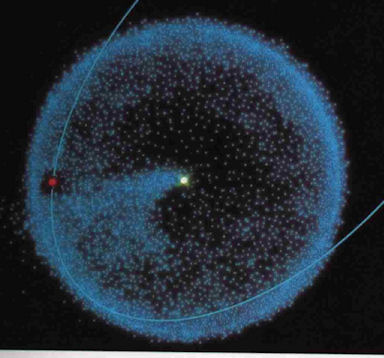
Written by Andy Lloyd, 18th June 2015
References:
1) The Daily Galaxy "The "Oort Star" --Did a Rogue Star Pass Through Our Solar System? 14 June 2015 (Article on longer online)
The Aquarius Connection
My friend Lando has been researching Nibiru's
position in the sky. A while ago he wrote to me explaining: "After further research on
chapters 1&2 in the Lost Book of Enki, and comparison to the charts
posted on your web site seem to be consistent with Alalu's description
and position, I've come accept that your analogy is 100% correct.
Nibiru is part of the Dark star system! Which has just pass
Jupiter on its way out of the system while the ferry which is Nibiru, is
moving in pass Neptune on it way to Uranus.
When do you think it will Arrive? or if it will
come this far into the system at all this circuit? Hard to tell with MS
world telescope" (1) He has subsequently sent me this image which he thinks might be of Nibiru.
May 2015 The image was taken from
Microsoft on 16th May 2015, and he's been tracking this red speck's
progress for a while. "I copied that myself from
Microsoft telescope, and my cell phone software." (2) Neptune is currently in the constellation Aquarius
(3), which is not one of the most exciting star regions in the sky.
This red blob doesn't look much like a star to me - if it was, I guess
it could have been Chi Aquarii (χ Aquarii), which is a
fairly bright red giant. Another feature of the constellation is
the M2 globular cluster, but I've not seen images of this that show it
as red. As far as I can tell, there are no other planets in
Aquarius (the obvious candidate being Mars, which was in Scorpius/Libra
around that time). So, I can't think of an obvious explanation for
the red blob, although it doesn't really look like it 'fits' with the
rest of the picture, in terms of its luminosity etc.
November 2014 However, Lando previously sent me a better image of
this object, in November last year (right, below) which is certainly
more authentic in appearance. It is said to have been passing
Neptune and Uranus at the time (4), so it obviously a pretty slow-moving
object if it's remained in Neptune's vicinity for 6 months.
Therefore, either it's way out in the outer solar system, or it's a
background object embedded in the Aquarius constellation (χ
Aquarii? It looks a lot more like a large red star on this
image). Back in June 2013, Lando offered me the following
coordinates for Nibiru (taken from the Microsoft World telescope)
(5): RA: 06H 08M 55s DEC: 22: 47: 06 And also for the 'ferry' (6):
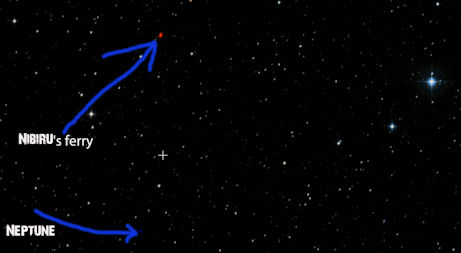
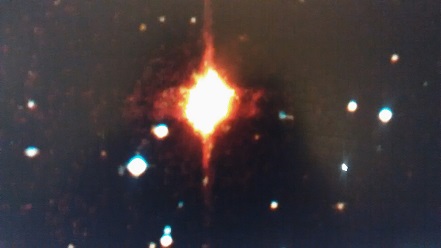
So, the 'ferry' coordinates are for the Aquarius object that Lando's been talking about, which lies pretty much on the ecliptic in the middle of the Aquarius constellation..
Compare these coordinates to the globular cluster M2 (7): RA: 21H 33.5M Dec. -00: 49
And to the coordinates of the red giant χ Aquarii (8): RA: 23H 16M Dec. -07: 43
Therefore, it's definitely not the globular cluster M2. But it could be the red giant χ Aquarii, which has a magnitude of 5. That lies to the right of the constellation image of Aquarius, just below the blue line of the ecliptic.
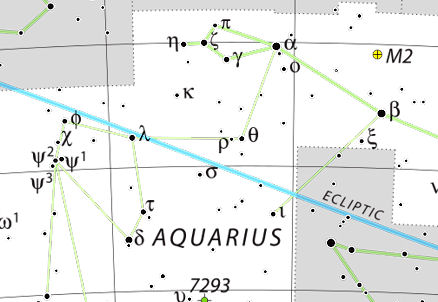
(9)
Again, this all depends upon whether Lando's object is moving over time against the background star-field - something I'm unable to determine from the images he's sent me. So I can't rule out some kind of anomaly, but it seems most likely that this is simply χ Aquarii. As he points out, even if this is not 'the ferry', that doesn't mean it's not still out there waiting to be discovered!
Written by Andy Lloyd
, 18 June 2015
References:
1) Correspondence from Lando J., 9 August 2013,
2) Correspondence from Lando J., 16 May 2015
3) "Neptune at Opposition"
4) Correspondence from Lando J., 15 November 2014
5) Correspondence from Lando J., 22 June 2013
6) Correspondence from Lando J., 23 June 2013
7) Patrick Moore "Atlas of the Universe" 1999 p243
8) Chi Aquarii
9) Chi_Aquarii image
First Comet-like Planet Imaged
The
phenomenon that is Nibiru is equated with the ancient symbol of the
Winged Disk. For good reason, arguably: Given the cometary
nature of the rogue planet that passes through our solar system's
planetary zone every 3600 years or so (according to author Zecharia
Sitchin (1)), it seems plausible that the solar wind emanating from the
Sun would drive off volatiles from the otherwise frigid outer world as
it moves through its perihelion passage. Like a comet, then, this
terrestrial world, this cosmic 'ferry', would appear like a giant red
comet in the sky.
The true nature of Nibiru remains a point of
conjecture. There is no argument that it is referred to in the
ancient Mesopotamian texts (2) in a planetary, or at least cosmic
capacity. Sumerologists have provided many explanations for the
name, preferring generally that Nibiru refers simply to the planet
Jupiter, ignoring its association with the colour red. The great
cosmic battle between Marduk and Tiamat lie at the core of this mystery,
for which Marduk earned the name 'Nibiru': "...
the star, which shineth in the heavens. May he
[Marduk]
hold the Beginning and the Future, may they pay
homage unto him, Saying, "He who forced his way through the
midst of Tiamat without resting, Let his name be Nibiru, 'the Seizer of the
Midst'! For the stars of heaven he upheld the paths"
(2) Marduk's presence in the heavens was truly
awe-inspiring. No pottering white planet this: "He set the lightning in front of him, With burning flame he filled his body"
(2) Personally, I think that Marduk is a more powerful
planet than even Jupiter, and proposed many years ago that this
mysterious celestial object was actually a failed star, or sub-brown
dwarf (3,4), an idea that has become an important revision to Sitchin's
controversial theory over the last decade or two. The exact nature
of 'Nibiru' remains a mystery. Perhaps it is simply the sub-brown
dwarf Marduk passing through the solar system periodically.
Perhaps it is an outlying terrestrial planet of the sub-brown dwarf
system passing through the planetary zone as Marduk skims its boundaries
- hence the ancient moniker 'ferry'. Either way, its appearance is
not that of one of the regular planets. Instead, the 'star'
appears to be surrounded by some kind of aura, or halo, swept back by
the powerful solar winds to create the classic Winged Disk look.
Up until this month, there had been no scientific
precedent for a planet taking on the appearance of a comet. Now we
know that such an object does exist; a
Neptune-size planet
that lies about 33 light years away in the constellation Leo, and known
as
GJ 436b
(5). It was detected using
the
Hubble Space Telescope and Chandra X-ray Observatory.
Unlike Nibiru,
GJ 436b
is a relatively small 'Hot Jupiter' gas giant swinging around its parent
red dwarf star in a very tight circle whose radius is a puny 3 million
kilometres. The cloud of gas emanating from this boiling world is
truly awe-inspiring, at about 50 times the volume of the parent star: "The cloud of gas around GJ 436b, made up mostly of hydrogen, has a
circular head that surrounds GJ 436b, and a tail trailing behind the
planet. The diameter of the head is about 1.8 million miles (3 million
km), or five times the width of the host star, which is about half that
of the sun. The length of the tail is uncertain,
because the research team's observations do not cover it entirely, but
their computer models suggest it could be about 9.3 million miles (15
million km) long. "The scientists estimated
that GJ 436b is currently blowing off up to 1,000 tons of gas per
second. This means that GJ 436b is currently losing about 0.1 percent of
its atmosphere every billion years, which is far too slow a rate to
deplete its atmosphere in the lifetime of its parent red dwarf star.
However, when the star was more active in its infancy, the researchers
estimated that GJ 436b could have lost 10 percent or more of its
atmosphere during its first billion years." (6) The last paragraph of the above quoted article is
important to scientists because they wonder whether the small rocky
worlds found very close to parent stars began life as much larger gas
giants whose gases were blown off early on in the life of the parent
star. What is perhaps more interesting to Sitchinite proponents is
the anomalous appearance of a Neptune-sized gas giant skimming close to
a parent star. It's all the more surprising considering that the
parent star is a relatively cool red dwarf. “What we see is the planet
kind of turning into an enormous monster much bigger than its star,” Dr.
Ehrenreich said. The star is much fainter than our sun, and the
evaporating gases are not swept away. Instead, the star “allows the huge
cloud to gather". (7) It seems likely that many more of these kinds of
planets will be imaged in the future as scientists turn their attention
to 'Super-Earths' and 'Mini-Neptunes' in the years ahead, aided by new
powerful telescopes coming on line (6). 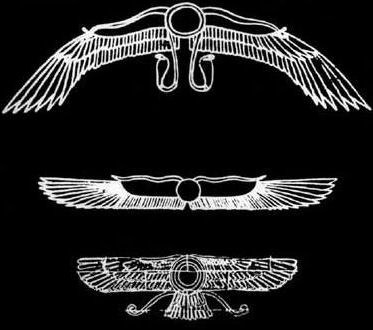
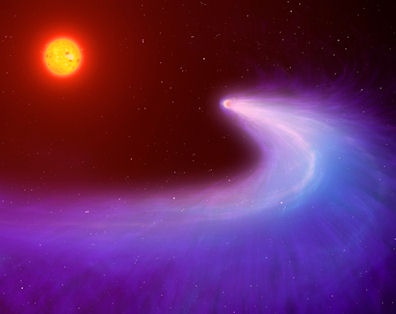
Written by Andy Lloyd, 27th June 2015
References:
1) Zecharia Sitchin "The Twelfth Planet" Avon 1976
2) L. W. King (translator) "Enuma Elish: The Epic of Creation" London 1902,
3) A. Lloyd "The Dark Star Theory", Feb 2000
4) A. Lloyd "Dark Star: The Planet X Evidence" Timeless Voyager Press 2005
Dark Star: The Planet X Evidence
5) David Ehrenreich et al "A giant comet-like cloud of hydrogen escaping the warm Neptune mass exoplanet GJ 436b", Nature, 522: 459–461, 2015
6) Charles Choi "Bizarre Cometlike Alien Planet Is First of Its Kind" 24 June 2015, with thanks to Lee
7) The New York Times "A Planet with a Tail Nine Million Miles Long" 25 June 2015
Could this Object be Nibiru?
I've
been sent two very curious images from an academic astronomer friend of
mine which is suggestive of a Nibiru-like object (1). He first
came across the coordinates on a blog written by Christian researcher
Lyn Leahz (2), who is interested in the return of Planet X/Nibiru.
The images
he sent to me (right) have come from the SkyView digitized sky survey (3) and an analogous
image taken from the Aladin interactive sky atlas (4), based upon these
coordinates. As my friend says, they are certainly suggestive of
a Winged Disk-type object - as described in my previous blog item.
My friend suggests a number of possibilities for this
object: "Hi Andy,
"I found the coordinates
surfing on Internet briefly. So I inputted them into the
professional astronomical websites and I got it. It is an IRAS
body, first observation in 1990. It is catalogued as a F5II
star, so one a bit larger than the Sun. It could be also a
reflex, because this is a collage of frames from different
observations, but it is really similar to the famous winged-disk.
"There are others stars
in Aladin with wings, but very faint compared to this one.
This object is next to the ecliptic. Next month I have access
to a big telescope, I might try some shots to see the colours and
compare with F-stars, for example. "Coordinates are Rad 5
and Dec. +22, magnitude 10.3 in V, very bright. It sounds
strange if it is Nibiru, because it is so bright, but it has a motion like stars,
perhaps a bit faster, so it could be a far planet, which,
because it was not observed very much, was thought to be a star.
Or it is all a lie and they know what it is and now for certain
reasons they let the truth come out. Or it is really a star
with a fictitious effect and nothing interesting." (5) Looking at my star maps, this object would appear to
be quite close to the Crab Nebula (M1) in Taurus (R.A: 5h 34m Dec:
22).
It'll be interesting to see if the images my friend manages
to take of it with a large telescope compare to the Aladin/SkyView
images in terms of the apparent wings - an independent, direct
observation would be able to clear up whether this is indeed an imaging
artifact, or an anomaly created by knitting together the mosaic of
images in the original sky survey. If we can rule out these kinds
of effects, then there may really be a mystery here to ponder. If
this is indeed a closer object than the catalogue suggest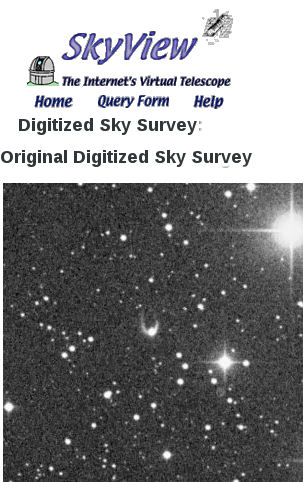
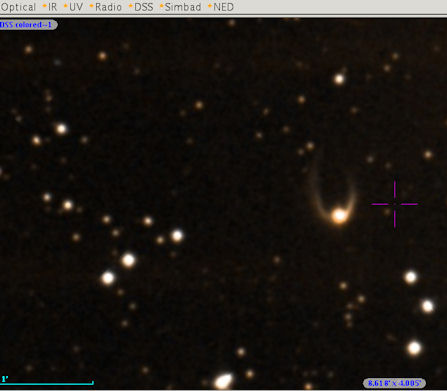
Written by Andy Lloyd, 28th June 2015
References:
1) Correspondence from Akeem, 26 June 2015
2) Lyn Leahz "Urgent! NASA Has Just Been Caught In A Huge Lie, and We Are In Serious Trouble! It Is Time To Pray Like Never Before!" 24 June 2015 (original article no longer online, but see):
3) Skyview imaging
4) Aladin sky imaging
5) Correspondence from Akeem, 28 June 2015
More Anomalies on Ceres
As the Dawn probe spirals down into an ever-closer orbit around the dwarf planet
Ceres, the mapping images it's sending back continue to astound. The
mystery of the 'lights' seen in one of its craters continue. We now know
them to be multiple spots of bright light (1), most likely sunlight reflected
back from large areas of ice or salt on the crater floor.
At the moment,
however, it's too early to know for sure: "At least eight spots can be seen
next to the largest bright area, which scientists think is approximately 6 miles
(9 kilometers) wide. A highly reflective material is responsible for these
spots -- ice and salt are leading possibilities, but scientists are considering
other options, too. Dawn's visible and infrared mapping spectrometer
allows scientists to identify specific minerals present on Ceres by looking at
how light is reflected. Each mineral reflects the range of visible and
infrared-light wavelengths in a unique way, and this signature helps scientists
determine the components of Ceres. So, as the spacecraft continues to send
back more images and data, scientists will learn more about the mystery bright
spots." (2) As I speculated in last month's blog, I think it likely that
these lights were caused by a relatively fresh impacts clearing away a thin
outer layer of rock and dust to expose ice below. "...the bright lights might be
relatively fresh impact areas that have exposed the pristine ice below, which is
then highly reflective in sunlight." (3) Looking at this new image, I think that this remains a
distinct possibility. We may be looking at some kind of peppering effect
in the crater post-impact. Other scientific commentators wonder if they
might be evidence of ice volcanoes on Ceres? An ice volcano is thought to
exist on Saturn's moon, Titan, according to some geophysicists (4).
Additionally, a network of ice volcanoes is spewing out oceanic water from the
interior of the tiny moon Enceladus into space, helping to create Saturn's
E-ring (5). So, there are precedents in the outer solar system for this
kind of geophysical activity.
If the discovery of the anomalous 'lights' on Ceres was not
enough, the appearance of an enormous, isolated 'pyramid' about the size of Mont
Blanc, the largest mountain in the Alps, has set many commentators' pulses
racing (6), fuelling the ancient E.T. debate doing the rounds (7). Dawn
probe images taken on 14th June show a 5km-high mountainous
structure with steep slopes protruding from a relatively smooth area
of the dwarf planet’s surface. NASA considers it to be 'intriguing'
(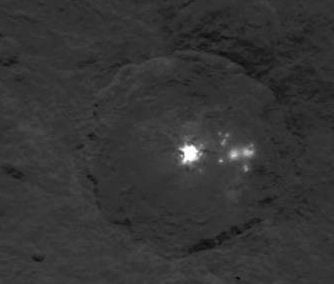
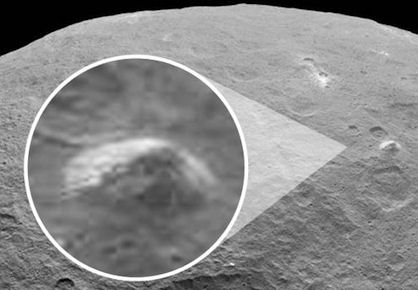
Written by Andy Lloyd, 27th June 2015
References:
1) NASA/JPL "Dawn Survey Orbit Image 11" 22 June 2015
2) NASA/JPL "Ceres Spots Continue to Mystify in Latest Dawn Images" 22 June 2015
3) A. Lloyd "The Lights of Ceres" 25 May 2015
andylloyd.org/darkstarblog26.htm
4) Jonathan Amos "'Ice volcano' identified on Saturn's moon Titan" 15 December 2015
5) Maddie Stone "Enceladus's Ice Volcanoes Are Feeding Saturn's Rings" 19 April 2015
6) Jon Austin "Ceres' alien PYRAMID will 'unlock key to ancient ET race and origin of man', claim UFOers" 24 June 2015
7) Jon Austin "Conspiracists find 'certain proof' of alien CITY and UFO by Ceres' light spots" 8 June 2015
Radiant Solar Cross
A beautiful gold artifact, found about 20 miles from
Stonehenge in 1947 by the late Guy Underwood, has gone on public display for the
first time in Devizes, Wiltshire (1). Quite why it was kept under wraps
for these past six decades is anyone's guess - the disk has been
'preserved by Dr Denis Whitehead since its discovery'
and was only seen by archaeologists at the town museum in 2013 (2).
Image credit: Wiltshire Museum It is one of only six such golden sun-disks unearthed in Britain, dating from
the Bronze Age: "The gold sun-disc, which was
forged around 4,500 years ago at around the same time the main circle of
Stonehenge was erected, was discovered in the Bronze Age burial mound of
a local chieftain. Thought to represent the sun, the thin sheet of
embossed gold features a cross at the centre surrounded by a circle.
Each is decorated with dots that glint in the sunlight. The
mysterious sun-disc, which was discovered alongside the remains of a
skeleton of an adult male at a burial mound at Monkton Farleigh in 1947
, is now on public display for the first time at the Wiltshire Museum in
Devizes, Wiltshire to mark the summer solstice."
(1) Although this curious solar cross dates from about
2400BCE, I was struck by its similarity with early Christian Chi-Rho
motifs, particularly those incorporated into Graeco-Roman mosaics (3),
as well as items of Etruscan-style micro-mosaic jewellery (4). The
mosaic broach shown (right) is a particularly close match to the Monkton
Farleigh sun-disk. Now, this broach was likely crafted in the late
19th century by the Castellani family in a revivalist Etruscan style
(4). So, the remarkable similarities between these two items are
mere coincidence. Unless, that is, these are examples of an
iconic symbol that finds its origin way back in the mists of time.
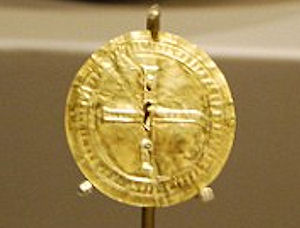

One might readily argue that these are examples of solar symbols. Other supposed solar symbols from antiquity include the famous Winged Disks. It also bears a strong resemblance to the Maltese cross. I've discussed similar symbolism regarding ancient Winged Crosses, bizarrely in a very popular webpage about a famous footballer's tattoo! (5) The Winged Cross symbol has ancient origins, and perhaps it is unsurprising that it forms the basis for such modern tattoo art.

The Banquet Stele from Nimrud
One of the finest examples of this form of symbolism is a Mesopotamian Winged Disk unearthed in 1951 in Northwest Palace of Nimrud in modern-day Iraq - the "Banquet Stele" created during the reign of Ashurnasirpal II (883-859BCE) (6). Could there really be a connection between the symbolism in this Mesopotamian stele, and the 4,500 year old gold broach dug up in the English countryside? On the face of it, this is simply coincidence. But what if there is a common factor - an important celestial phenomenon recorded occasionally in history, and pre-historically, which forms the basis for an important religious symbol spread across ages and cultures?
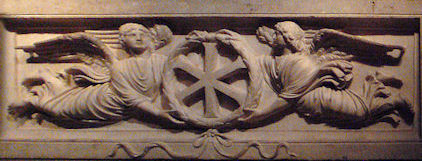
Sarcophagus on display at Le Grand Palais, Paris
Many of these cultures borrowed symbols and art forms from each other. Compare the Mesopotamian 'Banquet Stele' with the fourth image here, that of a sarcophagus from Constantinople circa 400AD showing the Christian XI symbolism (which, itself, is presumably a later adaptation of the early Chi-Rho Christogram) (7). These may be angels carrying the disk symbol, but the overall effect is very similar to an Egyptian Winged Disk. Again, this kind of symbolism flows through all of these
cultures, irrespective of any obvious connection they may have.
Written by Andy Lloyd, 30th June 2015
References:
1) Richard Gray "Stonehenge's sun-disc revealed: Rare 4,500-year-old gold decoration found in grave near sacred site goes on display" 23 June 2015 with thanks to Lee
2) Moss "Jug's Grave" 19 June 2015
3) Chi Rho
4) "Gold Micro Mosaic Brooch from The Vatican with Etruscan Beading c. 1820" 2011
5) A. Lloyd "David Beckham's Winged Cross Tattoo" 15 June 2004
6) Mathilde B. on Study Blue "Mesopotamian Art"
7) Constantinople Christian sarcophagus with XI monogram, circa 400AD (Wikimedia Commons, 2009)

You can keep informed of updates by following me on Twitter:
![]()
Or like my Facebook Page: https://www.facebook.com/darkstarandylloyd